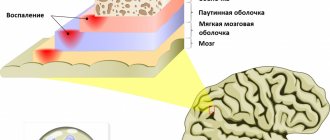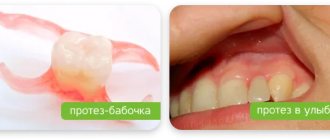Why does a tooth hurt after treatment: main reasons
One of the main questions patients have after visiting a dental clinic is: “Can a tooth hurt after treatment?” Unfortunately, this cannot be ruled out. The intensity and duration of discomfort depends on the amount of work performed, the individual characteristics of the body, and the sensitivity of the tissues. The main reasons why a person has a toothache after root canal treatment include:
- residual symptoms after dental procedures;
- progression of the inflammatory process;
- medical errors during cavity preparation;
- violation of seal installation technology;
- allergic reaction to filling material.
As practice shows, any intervention on the part of a dentist can provoke discomfort and pain in a person. They often occur during the treatment of deep caries (pulpitis), when the cavity in the tooth reaches large sizes. All manipulations are carried out under the influence of a local anesthetic, but when the effect wears off, discomfort may appear.
The cause of pain is often that the tooth is “overheated.” Enamel is the densest tissue in the body. To eliminate tissues affected by caries, a bur is often used, which rotates at high speed and high temperature. As a result, the nerve overheats. It gradually dies, and the tooth begins to hurt very much. To cope with this problem, the doctor has to remove the filling material and remove the inflamed nerve.
Only a dentist can identify the exact cause of pain. At the same time, he takes into account the clinical picture, the nature of the pain and diagnostic results (if necessary). For example, if a person has acute or throbbing pain, the cause is highly likely to lie in the development of acute pulpitis. And if the pain is periodic, then in the development of chronic pulpitis.
Why are patients afraid to remove nerves in a tooth?
Previously, in the process of removing a nerve in a tooth, dentists used arsenic by applying it to the affected pulp. The patient was then given a temporary filling, which was removed two days later along with the arsenic, after which the nerve was removed. This procedure took quite a long time, causing discomfort. Currently, thanks to modern technologies, the process of removing a nerve in a tooth lasts about half an hour and is carried out under local anesthesia. If the X-ray results are good, the canals and the carious cavity, cleared of bacteria, are filled.
To avoid such radical actions as removing a nerve in a tooth, you must:
- Carry out hygiene procedures as efficiently as possible
- Don't forget the importance of professional teeth cleaning
- Regularly visit the dentist, who will notice any carious lesion during a visual examination much earlier than it reaches the pulp and requires removal of the nerve.
How long can a tooth hurt after treatment?
Many patients are interested in how many days the tooth hurts after treatment. The occurrence of discomfort during the first 3–7 days is normal. During dental procedures, the tooth becomes sensitive if you touch it (it is recommended to chew on the opposite side). If the pain lasts longer than 5 days, and other negative symptoms are added (for example, increased body temperature or swelling of the gums), you should immediately seek help from your doctor.
Causes of pain during root canal treatment
The most common and most unpleasant complication of endodontic treatment for patients is pain after filling the root canals of a tooth. This is not always considered a pathology, since during the first 7 days the persistence of a slight aching soreness is normal and may be an individual reaction of the body. Severe pain indicates that treatment has not been successful. The reason for this may be:
- non-compliance with pulpitis treatment techniques;
- perforation of the tooth root;
- overestimation of the filling during restoration;
- poor cleaning of the root canal and pushing of infected tissue beyond the apical foramen;
- tool fragments in the channel;
- use of materials that cause irritation, allergic and neurotoxic reactions of periapical tissues;
- incorrect diagnosis [3].
Concomitant diseases of the patient increase the risk of complications after filling. For this reason, dentists always take a medical history to assess their general health and are more attentive to people who have diabetes, hypertension, hemophilia, etc.
Pain is possible even with an “ideal” x-ray picture. The severity of the pain syndrome can vary from slight pain when biting on a tooth to intense pain, comparable to pain in acute periodontitis, since the inflammatory process occurs in a very limited and enclosed space.
A tooth hurts after treatment: what to do?
If your tooth hurts a lot after treatment, and you don’t have an appointment with a specialist in the near future, you can try to cope with the pain yourself before your appointment. Below are the common methods:
- Rinse with a solution of salt and soda. This solution has an antiseptic effect, eliminates the inflammatory process, and reduces the severity of pain. To prepare it, add one spoonful of soda and salt to 250 ml of warm boiled water. Mix everything thoroughly. Rinse your mouth with the resulting solution for 5 minutes 3-4 times a day.
- Rinsing with a decoction of medicinal plants. Chamomile (has antibacterial and anti-inflammatory effects), sage (relieves inflammation, eliminates pain) are excellent. To prepare the decoction, take one tablespoon of raw material, add hot boiled water and leave to infuse for 30–40 minutes. The resulting solution is filtered and used for rinsing at least 2 times a day.
- Lotions with essential fir oil. Essential fir oil has an analgesic and anti-inflammatory effect. To get rid of toothache, just put 5 drops of fir oil on a piece of bandage or cotton wool and apply it to the painful tooth for 10-15 minutes.
- Applying a product with cloves and oil. Cloves have antibacterial properties and relieve pain well. To prepare the product, two cloves are crushed, mixed with a small amount of vegetable oil. The result is an anesthetic that is applied to the painful area for a few minutes.
- Taking non-steroidal anti-inflammatory drugs. Among pharmaceutical drugs, Ketoprofen, Nise, and Ibuprofen are in particular demand. Take strictly as indicated in the instructions.
It is important to note that some natural ingredients can cause allergic reactions, so you should be careful. If unpleasant sensations occur (for example, itching or burning), the procedure should be stopped.
Indications for root canal treatment in permanent teeth:
- acute and aggravated pulpitis;
- chronic pulpitis;
- caries of enamel and dentin (medium and deep stages);
- acute and aggravated periodontitis;
- chronic forms of periodontitis;
- tooth trauma with opening of the cavity and exposure of the nerve [1].
Filling can be carried out as planned, when the patient himself comes to the doctor as damage is detected, or as an emergency, as a result of acute pain.
Successful restoration of tooth shape and function with composites requires strict adherence to a number of steps:
- Preparing the patient for restoration. The dentist assesses the degree of tooth destruction, the condition of the periapical tissues, functional load, and the need to use an intracanal pin.
- Preparing the tooth for restoration. The doctor selects the colors of the restoration and removes tooth formations.
- Preparation of a carious cavity. The dentist selects a filling material, opens the enamel prisms, isolates the tooth from saliva, drys the cavity, applies a medical lining (if necessary), creates a hybrid layer from a moisture-resistant adhesive substance, applies the adhesive, introduces a composite material into the cavity, modeling the filling and final highlighting.
The criterion for a high-quality restoration is compliance with the shape of the tooth, the absence of overhanging edges of the filling, and the transition between the filling and the tooth tissue does not have a noticeable boundary.
“As the results of clinical trials have shown, endodontic manipulations in one root canal take from 40 minutes to 2 hours, depending on the condition of the canal.
Most of the time is spent on its mechanical processing. Filling one canal using the lateral condensation method without correction of the working length requires an average of 12 minutes Lutskaya I.K., Doctor of Medical Sciences, Professor, Head of the Department of Therapeutic Dentistry of the Belarusian Medical Academy of Postgraduate Education [2]
Advantages of visiting Dr. Martin dentistry
If you have a severe toothache after treatment, just contact Dr. Martin dentistry. Only experienced, highly qualified specialists work here. They will conduct an examination,, if necessary, prescribe a diagnosis to determine why the tooth hurts after treatment, and immediately solve this problem. In their work, doctors use only proven techniques and reliable modern equipment.
Numerous positive reviews from patients confirm the high quality of the services provided. At the same time, the cost of the procedures is affordable (you can find out more about the price list on the website). Free consultations are available to each patient. To make an initial appointment with a specialist at Dr. Martin dentistry, just call the phone number provided or fill out a standard form online, indicating your contact information - name and number.
What to do if the pain during dental canal treatment is unbearable
If there is a lot of pain after root canal filling, you should take a painkiller and immediately contact the doctor who provided the dental service. He knows how the treatment went and will advise the best way to solve the problem:
- Supplemental anesthesia: Used when standard anesthesia is ineffective. A stronger analgesic may be prescribed (for example, nimesil instead of Nurofen) and a tampon with the drug may be applied for several days.
- Changing treatment tactics: an initially incorrect diagnosis without taking into account the clinic, incomplete history taking, diagnosis, examination of the patient and the carious cavity lead to the wrong choice of treatment method. This is not always a doctor's mistake. Complications may develop as a result of exposure to factors of a different nature (pre-existing diseases, low body resistance, injury, individual reaction, etc.).
During the re-examination, a new treatment regimen will be developed to eliminate pain and its causes. It may be necessary to refill unsuccessfully made tooth canals.
Depending on the cause, treatment is prescribed:
- anti-inflammatory;
- desensitizing therapy;
- filling correction;
- root canal filling;
- resection of the root apex.
It happens that when you make a complaint again, the dentist reports that everything was done correctly and there is no reason to worry. However, the patient’s pain does not subside not only after a day, but also after several days, intensifying and continuing to cause discomfort. In this case, it is better to go to another clinic - they will change the filling, smooth out the consequences of the previous dentist’s mistakes and help save the tooth.










